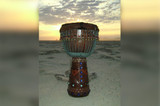History of Frame Drums and How They're Used Today
Drums come in all shapes and sizes, mostly depending on the origin of the drum and the culture that developed its use throughout the ages. Drums, however, have one thing in common – the basis of construction that is seen today in the simple, yet complex, frame drum.
In the U.S., frame drums are usually found today in Native American practices and celebrations. The circular wooden frame is covered by an animal skin that is indigenous to that culture’s roots. Circular frame drums are also found in Latin American regions, as well as South Asian and Middle Eastern areas. Other cultures, such as those found in the Asian region, have square or rectangle shapes, and there are even octagonal-shaped frame drums, but the construction of these drums and their ceremonial use is generally the same around the world.
European frame drums include the Irish Bodran, a drum that was thought to have evolved from the repurposing of a serving tray, played by striking the head with the hand or a mallet. Deff or Def drums hail from the Middle East, and can be found with jingles or rings attached, resembling the modern tambourine. North Africa’s frame drum is the Bendir and includes metal snares for a more raspy sound, while Plenera drums are the frame drum mainly seen in Puerto Rico.
Frame drums have been given a new life in today’s world of music, outside of performance. As one of the most portable drums that is easy to learn, frame drums are popping up in healing circles, music therapy settings and within facilitated drum circles. The ease of play make frame drums a favorite in a wide variety of locales, enabling a broad range of benefits for both the drum circle facilitator, as well as the patient in a therapeutic setting. Plus, frame drums are seen as less intimidating as other drums, based on the simple design and method of play, allowing beginners to beat out a rhythm easily, and encourage those with disabilities to reap the benefits of rhythm and music therapy.
For versatility and historical importance, a frame drum is not only one of the most common drums in all music today, but can benefit more than just the music it enhances. Bringing out the joy and love of music and rhythm, in a corporate setting, or as a therapeutic aid, has a ripple effect on the lives of those in the presence of the sound a frame drum creates.
Be sure to check out this demo of the Tycoon 18” Frame Drum, and be dazzled at the sound and rhythm possibilities!
Recent Posts
-
What is the Best Size Djembe for Beginners?
If you're new to the world of percussion and interested in learning the djembe, you're in for a t …16th Jul 2024 -
The Benefits of Becoming a Drumming Teacher: Transforming Passion into Profession
Why become a drumming teacher? Becoming a drumming teacher is an excellent way to share your pas …22nd May 2024 -
What Makes the Djembe Drum a Spiritual Instrument in African Music?
Origin and history of the Djembe drum The Djembe drum originates from West Africa and holds sign …16th May 2024



